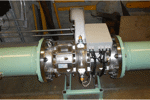SOURCE WATER CONTAMINATION RESOURCES
-
Funding The Fight Against PFAS And Lead In Drinking Water
An overview of funding opportunities for water utilities to meet new and upcoming compliance objectives, as well as technology considerations to reduce further contamination.
-
PFAS Technology Options Provide Water Treatment Solutions Per- and polyfluorinated substances (PFAS) continue to dominate the conversation as an emerging contaminant of concern due to their potential for adverse human health effects and continued regulation. This group of chemicals can be found in a wide variety of consumer products and drinking water.
-
New Water Quality Standards Will Result In Billions Being Spent To Remediate PFAS Contamination Recently, the U.S. EPA announced long-awaited water quality standards outlining the maximum contaminant levels for PFAS contaminants in drinking water. This marks the first time national standards for a new contaminant have been added to the Safe Drinking Water Act since 1996. It represents, without doubt, an ominous alert that should be noted.
-
Removing PFAS From Public Water Systems Will Cost Billions And Take Time — Here Are Ways You Can Filter Out Harmful 'Forever Chemicals' At Home
My team at the University of Notre Dame works on solving problems involving contaminants in water systems, including PFAS. We explore new technologies to remove PFAS from drinking water and to handle the PFAS waste. Here’s a glimpse of the magnitude of the challenge and ways you can reduce PFAS in your own drinking water.
-
6 Steps To Complying With New PFAS Drinking Water Regulations In April 2024, the U.S. EPA released regulations for PFAS limits in municipal drinking water, greatly impacting municipalities and the water industry as a whole. There are several steps that can be taken to successfully navigate the upcoming regulations.
-
Solutions In Bloom: How Flowers Are Being Used To Clean Up Polluted Waterways
Pollution and microplastics float down waterways that treatment plants have to manage. Alongside these contaminants are drifting flowers that clear aquatic habitats. Recent research shows they could be an organic method for removing phosphorus and nitrogen.
-
Lead From Old Paint And Pipes Is Still A Harmful And Deadly Hazard In Millions Of U.S. Homes The WHO estimates that more than 1 million deaths each year are attributable to lead poisoning. In more recent years, this number has risen at an incredible pace, with some research showing that nearly 5.5 million adults die from lead-related health complications. Understanding and addressing this persistent problem will require improved monitoring, targeted remediation, and a great deal more awareness and dialogue.
-
River Pollution Is Causing Harmful Outbreaks Of Sewage Fungus In The UK
The pollution of the UK’s waterways and coastlines with sewage is throwing its ecosystems out of balance. One well documented example is the spread of microscopic bacteria that can multiply rapidly into algal blooms, causing extensive dead zones once oxygen in the water has been used up. But there’s another pollution problem that has been largely overlooked, until now.
-
Arsenic In Landfills Is Still Leaching Into Groundwater Arsenic has long been considered "the king of poisons." Films such as "Arsenic and Old Lace" by Frank Capra and "The Name of the Rose" by Jean-Jacques Annaud illustrate the deadly effect that a high dose has on people. But when someone experiences arsenic poisoning, it's usually not the direct result of a diabolical plot — in fact, it usually isn't. So how do you figure out how the arsenic got into someone's bloodstream?
-
Mussel Fouling Prevention At Shepaug Hydroelectric Station
While the population of invasive mussels was very low along the Housatonic River in 2015, the population was expected to increase in the coming years. Firstlight Energy, a subsidiary of GDF Suez and operators of a number of hydroelectric facilities in Connecticut and Massachusetts, was concerned about the detrimental effect the anticipated increase would have on the cooling water systems of the Shepaug Hydroelectric Station.











